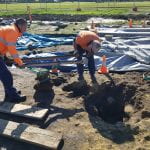First week back on the excavation and things are already looking exciting. See:
That’s Sylvana (Port Arthur) and myself being excited. Why? Because we’re not in the office, that’s why.
Due to the COVID we’ve had to re-jig things a bit. We’ve lost our beautiful archaeology crew, who are living it up in parts unknown. Instead, there’s us. Two beautiful specimens of humanity. Together with Port Arthur’s archaeological overlord, David Roe, we plan to work on the site for the next few months to acquit the research goals.
This means that we have needed to go back to the planning board to think about what we can achieve within time and budget. In an ideal world, these things would not apply – but, as 2020 has amply demonstrated, this is not an ideal world and so we have had to adapt. Luckily, being experienced in the ways of the field, we are pretty good at adapting to things.
First thing is that we cannot excavate the whole of the area. It is just not feasible in the time that we have. I had worked out an excavation rate based upon a crew of five working for eight months – this would have just managed to fully excavate the whole area. Given a crew of three and the time that we can dedicate to it, we have revised the excavation plan into a three stage process:
STAGE 1

The green squares show the area of excavation. The orthophoto from our photogrammetry has been used to plan the excavation targets
In this stage we will excavate two long slots across the site (sub-divided into a series of squares). These slots will provide us with information on the site’s profile – particularly the formation of the underlying natural geology and the relationship of the different phases of building to each other. This will answer a big research question about the location of the original pre-1830 waterfront, which we know was heavily modified during the convict period. By excavating across the main north west – south east axes of the workshops range, we will hopefully also determine if and how the post-1835 workshops range was modified into that from 1856.
STAGE 2
During this stage we concentrate upon one of the main spaces in the workshops range. From 1856 we know that is was used as a foundry and blacksmiths’ shop. Prior to that, it had potentially been used by shoemakers and carpenters. As such, it provides the best known opportunity to target convict labour processes and products at Port Arthur. In combination with the results from Stage 1 work (which also cross through the space), it will show us how space was adapted and used by the convict artisans. The artefacts that we recover will also help us understand activity areas (through concentration and distribution), as well as the efficiencies and process behind convict production.
STAGE 3
If things are motoring along, we’ll then turn our attention to the rest of the workshops range. As during Stage 1 and 2, this will provide information on the form of the structures and whether those from the 1830s were adapted from or replaced by those from the 1850s. The area also covers shops that were used for shoemaking and tailoring (1830s), as well as stores, steam engine, bone mill and blacksmith (1850s).
So, we might have scaled back the area, but this plan means we’ll still be able to engage meaningfully with our research goals. It’s going to be a fun summer…






Fantastic to see how you said you’d be scaling back the project. Still a lot of work for three people thought. Best of luck!